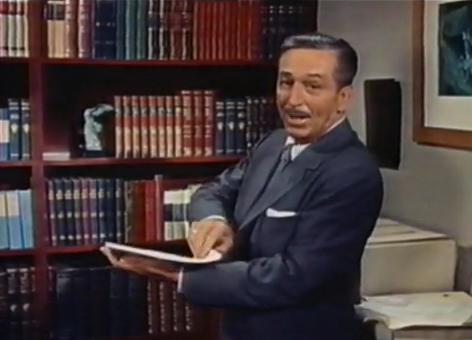It’s interesting watching children explore their world. There are some things they accept implicitly. You don’t have to explain them. And the thing about it is that this includes things that don’t exist. This may be why things like the Tooth Fairy and Santa Claus hold so much weight in children’s worlds; they make sense to kids in a way that doesn’t need to be explained. We are absolutely not teaching the kids that Santa is real, but I feel as though my son is starting to absorb the idea anyway, because it’s one of the implicit assumptions of his world.
I think this ties into Walt Disney’s concept of “the plausible impossible.” This is an episode of The Wonderful World of Disney, back in season three when it was called Disneyland, about the idea of how reality factors into the fantasy world of animated cartoons. It includes “Thru the Mirror,” the old Mickey Mouse cartoon play on Through the Looking Glass; “Donald’s Cousin Gus,” a cartoon where Donald is eaten out of house and home; a brief clip of the forest fire sequence of Bambi; “Night on Bald Mountain” from Fantasia (and brief clips of the dinosaurs and the Sorcerer’s Apprentice); and the deleted soup-eating scene from Snow White, which I believe had been unseen up until the point that it appeared on this episode. There are also a few original clips to illustrate concepts.
Walt’s premise, which he insists is not new but which I had not heard articulated before I saw this, is that fantasy must be grounded in reality. He uses various things’ hitting Donald Duck on the head to explore the idea that, although we know that a head won’t clonk like a coconut if you hit it, it feels grounded in reality. Mickey Mouse runs off a cliff, and we believe there is enough momentum for him to get back on it if only he tries. This may be in part because we’re familiar with the trope, but the trope had to make a certain amount of sense to become so common, right?
He also points out that the music from “Night on Bald Mountain” could fit several other bits of the studio’s animation. There is no inherent reason that it works best with haunts rising out of a graveyard; it could as easily be Bambi and his father in danger or dinosaurs fighting or Mickey calling up the waves. We accept that it is how we have seen it because it is how we have seen it. But it’s music, and there’s nothing in the music to force the image on us.
The idea that we have five senses is outdated, and one of the senses we have that isn’t on that list is a sense of how the world around us works. We have certain expectations of things like gravity. Let’s face it; animation as a genre tends to play with our basic sense of rightness in how the world is. It’s full of anthropomorphized animals, toying with the laws of physics, and weird anatomy. My son watches at least one cartoon that’s set in a mostly featureless white in almost all episodes. Why does it work for him? Why is he accepting that the Mickey Mouse Clubhouse rises out of the ground? Why are we all so okay with the interminable nephews?
This is the sort of thing that Walt and company had to think about in order to keep their work going. There’s a reason some animation is more successful than others, and it has at least a little to do with the believability of the worlds. It doesn’t surprise me at all to learn that Walt put enough thought into it to make an entire episode of a TV show; honestly, I’d love to see even more exploration of the idea. Maybe I’ll be forced to write something myself.
As an interesting final note, the official name for the mountain in “Night on Bald Mountain” is Chernobog. (“Night on Bald Mountain” is a tone-poem, you guys, an actual one!) Or Chernabog, or Czernobog, or however you feel like spelling him. Making him the only Disney character I know of to also be played by Peter Stormare. But it’s interesting that this name, so far as I can tell, is canon without being in the film—both in Fantasia itself and here, he’s referred to as Satan.
I rented this on Amazon; help pay for more rentals as needed by sponsoring my Patreon!

